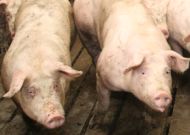 he pork industry is moving quickly to curb the spread of porcine epidemic diarrhea virus (PEDV).
he pork industry is moving quickly to curb the spread of porcine epidemic diarrhea virus (PEDV).The National Pork Board announced this past week it would contribute $450,000 to research toward understanding the virus, which was positively identified less than a month ago.
Chris Novak, pork board CEO, said this is paired with a $77,000 commitment from the Iowa Pork Producers Association.
“Producers are dealing with this for the first time here (in the U.S.),” he said at the World Pork Expo June 6. “We need to identify how it got here and the steps we need to take to manage it.”
Paul Sundberg, a veterinarian and vice president of science and technology for the pork board, said the virus affects pork production, primarily young pigs under three weeks of age.
“We are continuing to gather information and learn more about it,” he said. “So far it has been found primarily in the Midwest.”
Mortality rates have been high for younger pigs. Sundberg said older pigs infected by the virus usually recover.
“We are working with the American Association of Swine Veterinarians to put a survey out to vets who are dealing with the initial disease break.”
He said initial reports indicate the virus is much like TGE — transmissible gastroenteritis.
The pork board also announced changes in its PQA Plus program.
Conley Nelson, a producer from Algona and immediate past president of the pork board, said the program is tweaked every three years.
Among the changes, producers will be required to pass a test for certification, and online registration also will be possible.
Nelson said other changes included more farmer interaction as trainers and advisers are being certified, as well requiring correction plans should problems arise during a site inspection.
Novak also discussed a new sow-housing calculator that will be available to producers for free at the pork board’s website: www.pork.org.
“This will evaluate the financial impact of any change on the farm when it comes to housing,” he said.
Novak also announced a new worker-safety initiative designed to collect data and reports on worker injuries and to allow operations to see how they are doing compared to other hog operations.
Karen Richter, a producer from Montgomery, Minn., and newly elected pork board president, said the unveiling of three newly named products — the porterhouse pork chop, ribeye pork chop and New York pork chop — should benefit consumers.
“We really believe this will simplify things when people are purchasing these chops, she said. “We are confident the new names and labels will help the consumer.”





